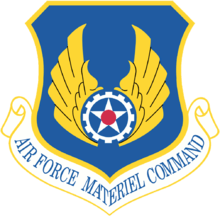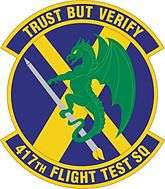417th Flight Test Squadron
417th Flight Test Squadron
 | |
|---|---|
 417th Flight Test Squadron Boeing YAL-1A | |
| Active | 1989–1995; 2006–2012 |
| Country |
|
| Branch |
|
| Type | Squadron |
| Role | Flight Testing |
| Part of | Air Force Materiel Command |
| Garrison/HQ | Edwards Air Force Base, California |
| Decorations | Air Force Outstanding Unit Award[1] |
| Insignia | |
| 417th Flight Test Squadron emblem (approved 25 June 2007)[1] |
 |
| Aircraft flown | |
| Electronic warfare | Boeing YAL-1A |
| Transport | McDonnell Douglas C-17 Globemaster III |
The 417th Flight Test Squadron is an inactive United States Air Force squadron. It was last assigned to the 412th Operations Group at Edwards Air Force Base, California, where it was inactivated on 14 February 2012. The squadron was first activated in 1989 as the 6517th Test Squadron and conducted flight testing of the McDonnell Douglas C-17 Globemaster III until it was inactivated in 1995 as the 417th Test Squadron. It was reactivated in 2006 and performed ground and flight testing on the Boeing YAL-1A until 2012.
Overview
The 417th Flight Test Squadron performed flight testing on Boeing YAL-1A Airborne Laser aircraft (ABL). The ABL was an airborne-directed energy weapon system. The YAL-1A is a prototype that employs a highly modified Boeing 747-400 airframe equipped with sensors, lasers and sophisticated optics to find, track and destroy ballistic missiles in their boost, or ascent, phase.[2]
The program was terminated due to budget reductions on 14 February 2012. The YAL-1A Airborne Laser Test Bed aircraft was ferried to Davis Monthan AFB, Arizona where it was placed in storage by the at the Air Force’s Aerospace Maintenance and Regeneration Group.[3]
History
C-17 GLobemaster III
Established in 1989 as the 6517th Test Squadron to perform flight testing on the new McDonnell Douglas C-17 Globemaster III] airlifter which was developed by McDonnell Douglas to replace the aging Lockheed C-141 Starlifter. The squadron received its first YC-17A (T-1) in late 1991 (87-25). Five more C-17A production models (88-265, 88-266 (P-1, P-2, LotI)), (89-1189 - 89-1192 (Lot II, P-3, P-4, P-5)) participated in extensive flight testing and evaluation. Testing was completed and the first production model was delivered to the 437th Airlift Wing, Charleston Air Force Base, South Carolina on 14 July 1993.[4][5]
The first C-17 squadron was operational (17th Airlift Squadron) in January 1995. The squadron was inactivated on 1 October[1] and C-17 support was transferred to the 418th Flight Test Squadron.[6]
YAL-1A Airborne Laser
Was re-activated in March 2006 for ground and flight testing of the YAL-1A Airborne Laser (ABL)aircraft. The ABL is a component of Missile Defense Agency's boost-phase segment designed to destroy enemy missiles soon after they are launched to provide defense of the United States, its international allies, and its deployed troops.[2]
In February 2007, the ABL began a series of flight tests, which included the first in-flight firing of the TILL targeting laser at a simulated target, in March 2007. This was followed by flight tests of the BILL illuminating laser and tests of TILL, BILL and a surrogate high-energy laser (SHEL) low-power laser. Installation of the six COIL laser modules was completed in February 2008. The first firing ('first light') of the COIL laser took place in September 2008. The test lasted less than a second and was followed by further ground tests of increased duration and power. In November 2008, the COIL laser was fired and focused through the beam control / fire control system.[7]
A high energy laser aboard the aircraft was successfully fired from Edwards Air Force Base in August 2009. The YAL 1A laser travels at the speed of light to destroy ballistic missiles in their boost phase of flight. In January 2010, the high energy laser was fired to intercept a test Missile Alternative Range Target Instrument (MARTI).[7]
In February 2010, the US MDA and Boeing jointly tested the speed, precision and breakthrough potential of directed energy weapons deployed in the ABL test bed.[7] In 2010, the ALTB successfully knocked a “threat representative” missile out of flight from a distance of 50 miles. This resulted in the program receiving an additional $40 million in funding even though the Secretary of Defense himself admitted it wasn’t realistic. However, in that same year the device failed two tests in a row. In 2011 funding was eliminated as the program was eight years behind schedule and it had a staggeringly large budget of $500 million per year.[8]
Lineage
- Designated as the 6517th Test Squadron and activated on 10 March 1989
- Redesignated 417th Test Squadron on 2 October 1992
- Redesignated 417th Flight Test Squadron on 1 March 1994
- Inactivated on 1 October 1995
- Activated on 16 March 2006[1]
- Inactivated on 14 February 2012
Assignments
- 6510th Test Wing (later 412th Test Wing), 10 March 1989
- 412th Operations Group, 1 October 1993 – 1 October 1995
- 412th Operations Group, 16 March 2006 – 14 February 2012[1]
Stations
- Edwards Air Force Base, California, 10 March 1989 – 1 October 1995
- Edwards Air Force Base, California, 16 March 2006 – 14 February 2012[1]
Aircraft
- McDonnell Douglas C-17 Globemaster III, 1989-1995
- Boeing YAL-1 Airborne Laser, 2006-2012[1]
See also
References
- Notes
- 1 2 3 4 5 6 7 Butler, William M. (April 13, 2010). "Factsheet 417 Flight Test Squadron (AFMC)". Air Force Historical Research Agency. Retrieved January 8, 2017.
- 1 2 Grill, TSG Eric M. (December 6, 2006). "417th Flight Test Squadron stands up". 412th Test Wing Public Affairs. Archived from the original on October 30, 2012. Retrieved January 8, 2017.
- ↑ Fabara, Jet (February 24, 2012). "Airborne Laser Test Bed bids adieu to Edwards AFB". USAF Public Affairs. Archived from the original on October 30, 2012. Retrieved January 8, 2017.
- ↑ Norton,
- ↑ Air Force Serial Number Search, C-17 Globemaster III
- ↑ "Boeing History: C-17 Globemaster III". Boeing. Archived from the original on January 18, 2010. Retrieved January 9, 2017.
- 1 2 3 "Airborne Laser System (ABL) YAL 1A, United States of America". airforce-technology.com. Retrieved January 9, 2017.
- ↑ Rupert, Madison (February 22, 2012). "Airborne Laser Program Dumped After 16 Years and Billions Spent in Development". The Intel Hub. Archived from the original on May 1, 2012. Retrieved January 9, 2017.
Bibliography
![]()
- Norton, Bill (2001). Boeing C-17 Globemaster III. Warbird Tech. Volume 30. North Branch, Minnesota: Specialty Press. ISBN 978-1-58007-040-9.
